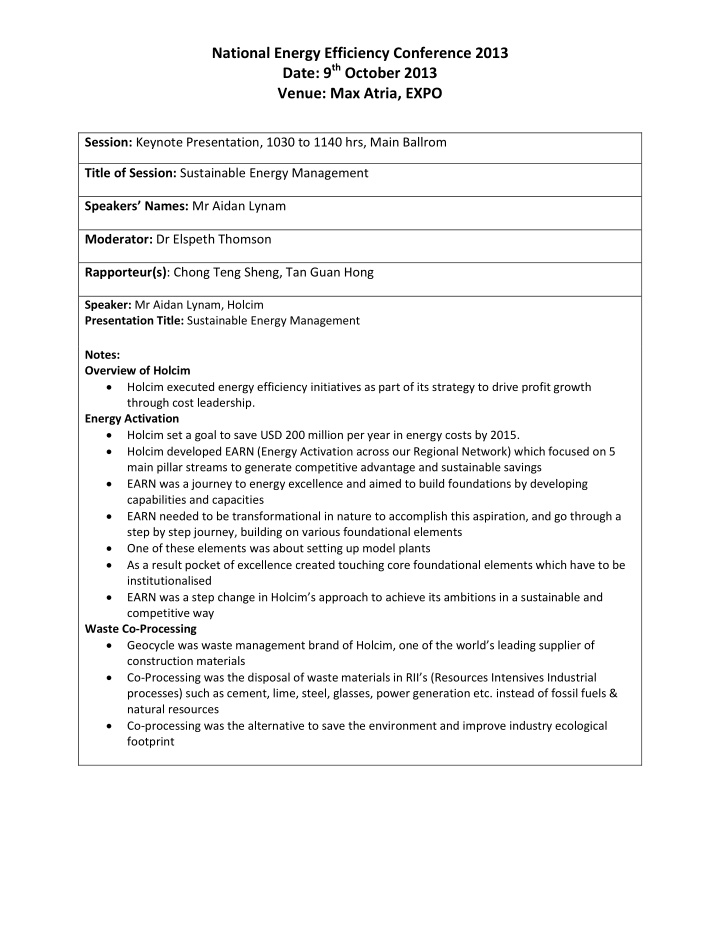



National Energy Efficiency Conference 2013 Date: 9 th October 2013 Venue: Max Atria, EXPO Session: Keynote Presentation, 1030 to 1140 hrs, Main Ballrom Title of Session: Sustainable Energy Management Speakers’ Names: Mr Aidan Lynam Moderator: Dr Elspeth Thomson Rapporteur(s) : Chong Teng Sheng, Tan Guan Hong Speaker: Mr Aidan Lynam, Holcim Presentation Title: Sustainable Energy Management Notes: Overview of Holcim Holcim executed energy efficiency initiatives as part of its strategy to drive profit growth through cost leadership. Energy Activation Holcim set a goal to save USD 200 million per year in energy costs by 2015. Holcim developed EARN (Energy Activation across our Regional Network) which focused on 5 main pillar streams to generate competitive advantage and sustainable savings EARN was a journey to energy excellence and aimed to build foundations by developing capabilities and capacities EARN needed to be transformational in nature to accomplish this aspiration, and go through a step by step journey, building on various foundational elements One of these elements was about setting up model plants As a result pocket of excellence created touching core foundational elements which have to be institutionalised EARN was a step change in Holcim’s approach to achieve its ambitions in a sustainable and competitive way Waste Co-Processing Geocycle was waste management brand of Holcim, one of the world’s leading supplier of construction materials Co-Processing was t he disposal of waste materials in RII’s (Resources Intensives Industrial processes) such as cement, lime, steel, glasses, power generation etc. instead of fossil fuels & natural resources Co-processing was the alternative to save the environment and improve industry ecological footprint
National Energy Efficiency Conference 2013 Date: 9 th October 2013 Venue: Max Atria, EXPO Key Findings: With rising energy prices, the pressure on the companies in this industry was increasing. This in turn, required them to drive programs towards higher energy efficiency. Holcim had proactively launched a focused strategy and transformation to drive down its energy consumption. This had involved creating a leaner energy culture in its production processes. Results had been promising, including savings in thermal and electrical energy, reduction of coal use and optimisation of clinker factor. Holcim also practised waste co-processing, whereby waste was reused as a raw material and a source of energy to replace natural mineral resources (material recycling) and fossil fuels such as coal, petroleum and gas (energy recovery). Holcim’s holistic approach was called EARN (Energy Activation across Regional Network) and builds upon uniform core elements across all Holcim’s pl ants in South and South-east Asia, with a mix of hard and soft capabilities at the centre. With EARN, Holcim had made some clear breaks with its past in achieving its energy aspirations in a environmentally and economically sustainable way. Key Recommendations: Energy efficiency initiatives were executed as part of Holcim’s strategy to drive profit growth through cost leadership EARN is NOT a technical project alone, it is a transformation initiative, to build a lean energy culture with raised competency levels to achieve energy management excellence The journey of energy efficiency needed to be transformational in nature and advance progressively building on various fundamental elements Important to drive behavioural change in a sustainable way Monitoring is important to close the loop in energy management Moderator: Dr Elspeth Thomson, ESI Issues Raised: Is scale of operation important in cement manufacturing? Yes. There is economy of scale in the cement industry; a larger plant will consume less energy consumption per unit production. What are some of the energy efficiency projects carried out in Holcim? Retrofits of old plants were done and some inefficient plants were shut down due to economically infeasible. Most projects do not require capital expenditure, but activating staff to shape behavioral change in energy efficiency. Does Holcim focus on recycling in cement manufacturing? As there is minimum amount of waste (1-2%) generated due to the optimised operation, there is little need to recycle the waste materials. What is the indicator that Holcim is using to benchmark against its plant energy consumption? A typical cement industry consumes 100kWh/ ton of cement. Holcim is consuming around less than
National Energy Efficiency Conference 2013 Date: 9 th October 2013 Venue: Max Atria, EXPO 90kWh/ ton of cement, and has set a roadmap to get below 80 kWh/ ton of cement. To achieve that, target on energy reduction is set on large consumption systems and focus on reliability is also a huge pillar in driving energy footprint. Is there any plan to use alternate energy instead of coal? It is possible to also use natural gas, however, coal is easily transported at the moment. Any measure used to determine how effective these changes are? There is no specific measure at the moment but it is reflect in the energy bills of Holcim, which are lowering at a rate faster than expected. From which management level are the coaches recruited? They are chosen by Lead coach who reports to the plant manager. The coaches have KPIs which are part of their compensation level.
Recommend
More recommend